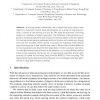Free Online Productivity Tools
i2Speak
i2Symbol
i2OCR
iTex2Img
iWeb2Print
iWeb2Shot
i2Type
iPdf2Split
iPdf2Merge
i2Bopomofo
i2Arabic
i2Style
i2Image
i2PDF
iLatex2Rtf
Sci2ools
SSD
2005
Springer
2005
Springer
On Discovering Moving Clusters in Spatio-temporal Data
A moving cluster is defined by a set of objects that move close to each other for a long time interval. Real-life examples are a group of migrating animals, a convoy of cars moving in a city, etc. We study the discovery of moving clusters in a database of object trajectories. The difference of this problem compared to clustering trajectories and mining movement patterns is that the identity of a moving cluster remains unchanged while its location and content may change over time. For example, while a group of animals are migrating, some animals may leave the group or new animals may enter it. We provide a formal definition for moving clusters and describe three algorithms for their automatic discovery: (i) a straight-forward method based on the definition, (ii) a more efficient method which avoids redundant checks and (iii) an approximate algorithm which trades accuracy for speed by borrowing ideas from the MPEG-2 video encoding. The experimental results demonstrate the efficiency...
| Added | 28 Jun 2010 |
| Updated | 28 Jun 2010 |
| Type | Conference |
| Year | 2005 |
| Where | SSD |
| Authors | Panos Kalnis, Nikos Mamoulis, Spiridon Bakiras |
Comments (0)

